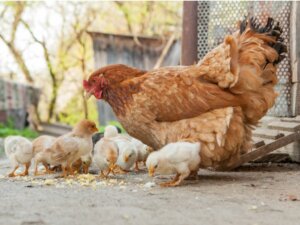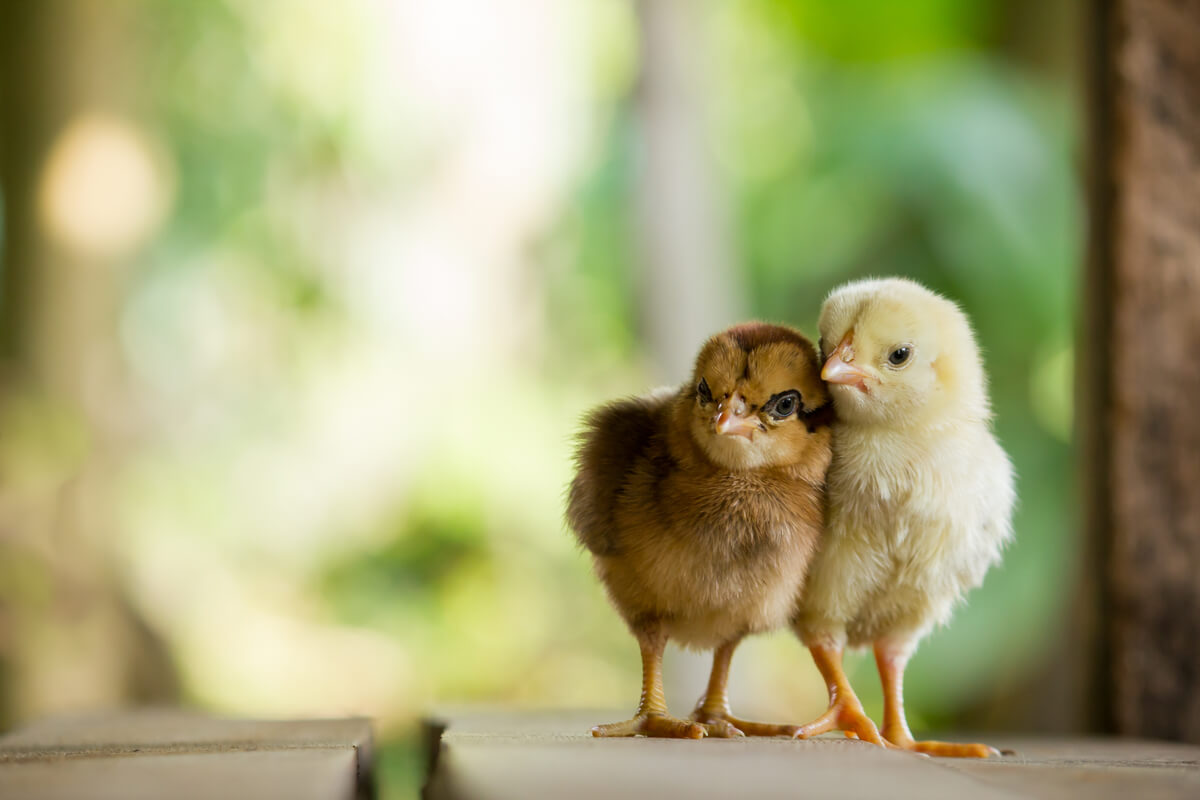Differences Between Chickens and Hens

The differences between chickens and hens, at the level of everyday language, are rather few. Chicken is a generic term used to designate the species Gallus gallus domesticus, but when it comes to speaking precisely from a zoological point of view, it’s necessary to know what separates hens, roosters, and chickens.
In this article, you can find out these differences, and we’ll also get to know these peculiar birds better, as it’s always a path full of pleasant surprises. Don’t miss it.
General information on Gallus gallus domesticus
The hen is a ground bird belonging to the Phasianidae family that lives in secondary forests. Originally from India, it has spread throughout the world due to the domestication process that humans made for its exploitation.
These birds live in groups of up to 20 individuals and are organized hierarchically, since in the nuclei a dominant rooster is surrounded by females and young chickens. This hierarchy is established through pecking, also among females, to decide which one will be the dominant one and will have the right to sleep near the rooster and eat first.
Their diet is fundamentally granivorous, as the hens spend most of the day foraging in search of food on the ground. However, they also incorporate animal protein into their diet in the form of small insects, worms, and slugs that they find while scavenging.
Due to their dietary choices, chickens are considered omnivorous animals.

Roosters and hens
Rooster and hen are the terms given to the male and female of this species respectively. Sexual dimorphism is clear in Gallus gallus domesticus, as males exhibit more striking colors, larger crests, and long tail feathers, as well as spurs on the legs to defend themselves. The hen, on the other hand, is smaller and more muted in color.
The behavior of both sexes also differs. Hens are less territorial and their hierarchy can be shaped according to needs. They’re sometimes organized horizontally for the shared rearing of chicks. Males, on the contrary, strictly mark their territory and are protective of the group.
The vocalizations of the hens are varied, but only the roosters emit the characteristic song that allows them to indicate their territory to other groups. In addition, they are the first to warn of danger with specific vocalizations. The hens reproduce this song and follow the rooster to safety.
Differences between chickens and hens
The term chicken can be used in a general way to refer to the species or to refer to the offspring of Gallus gallus domesticus. The young are also called “chicks”. This global character of the word is because, in juvenile specimens, males aren’t distinguished from females until they reach sexual maturity.
However, as the word hens is also sometimes used to designate a group of this species, we’ll now give you the main differences between chickens and hens.
Age
A chick is a baby hen. Until it reaches its adult state and its appearance differs according to the sex it has, the term isn’t changed. This species reaches maturity at approximately 5 months of age, at which point it becomes sexually active and the females are capable of laying eggs.
Appearance
The hen is covered with feathers and its head is crowned by a crest, although less obvious than that of the rooster. In addition, two folds of skin called barbels hang under its beak. Chickens or chicks, however, only have down, and their crest and chins still haven’t developed. Adult plumage doesn’t begin to appear until 2 months of age.
Behavior
While roosters and hens are strongly sexually differentiated, chicks show similar behavior that isn’t influenced by sex hormones. They’re very dependent on the mother and, from her, they’ll learn to forage, groom and socialize. As they develop, their personality will be defined.
Their relationship with humans
In general, when talking about wild birds, the word hen is used. However, when the context is how humans use this species for food (either for meat or eggs), the differences between chickens and hens are established in terms of the life expectancy of the animal.
Therefore, a hen is allowed to live until it can catch its eggs and chickens are the ones that are consumed, and this can be any time from 6 weeks to 18 months old.

Chickens are enigmatic animals, as, from a young age they only teach us their usefulness, not their nature. If you’re lucky enough to be able to deal with one of these birds, you’ll be amazed at the complexity of their personalities, their curiosity, and the strong group bond they share.
You’ll then see that the differences between chickens and hens are irrelevant because you’ll be more attentive to how amazing they are.
The differences between chickens and hens, at the level of everyday language, are rather few. Chicken is a generic term used to designate the species Gallus gallus domesticus, but when it comes to speaking precisely from a zoological point of view, it’s necessary to know what separates hens, roosters, and chickens.
In this article, you can find out these differences, and we’ll also get to know these peculiar birds better, as it’s always a path full of pleasant surprises. Don’t miss it.
General information on Gallus gallus domesticus
The hen is a ground bird belonging to the Phasianidae family that lives in secondary forests. Originally from India, it has spread throughout the world due to the domestication process that humans made for its exploitation.
These birds live in groups of up to 20 individuals and are organized hierarchically, since in the nuclei a dominant rooster is surrounded by females and young chickens. This hierarchy is established through pecking, also among females, to decide which one will be the dominant one and will have the right to sleep near the rooster and eat first.
Their diet is fundamentally granivorous, as the hens spend most of the day foraging in search of food on the ground. However, they also incorporate animal protein into their diet in the form of small insects, worms, and slugs that they find while scavenging.
Due to their dietary choices, chickens are considered omnivorous animals.

Roosters and hens
Rooster and hen are the terms given to the male and female of this species respectively. Sexual dimorphism is clear in Gallus gallus domesticus, as males exhibit more striking colors, larger crests, and long tail feathers, as well as spurs on the legs to defend themselves. The hen, on the other hand, is smaller and more muted in color.
The behavior of both sexes also differs. Hens are less territorial and their hierarchy can be shaped according to needs. They’re sometimes organized horizontally for the shared rearing of chicks. Males, on the contrary, strictly mark their territory and are protective of the group.
The vocalizations of the hens are varied, but only the roosters emit the characteristic song that allows them to indicate their territory to other groups. In addition, they are the first to warn of danger with specific vocalizations. The hens reproduce this song and follow the rooster to safety.
Differences between chickens and hens
The term chicken can be used in a general way to refer to the species or to refer to the offspring of Gallus gallus domesticus. The young are also called “chicks”. This global character of the word is because, in juvenile specimens, males aren’t distinguished from females until they reach sexual maturity.
However, as the word hens is also sometimes used to designate a group of this species, we’ll now give you the main differences between chickens and hens.
Age
A chick is a baby hen. Until it reaches its adult state and its appearance differs according to the sex it has, the term isn’t changed. This species reaches maturity at approximately 5 months of age, at which point it becomes sexually active and the females are capable of laying eggs.
Appearance
The hen is covered with feathers and its head is crowned by a crest, although less obvious than that of the rooster. In addition, two folds of skin called barbels hang under its beak. Chickens or chicks, however, only have down, and their crest and chins still haven’t developed. Adult plumage doesn’t begin to appear until 2 months of age.
Behavior
While roosters and hens are strongly sexually differentiated, chicks show similar behavior that isn’t influenced by sex hormones. They’re very dependent on the mother and, from her, they’ll learn to forage, groom and socialize. As they develop, their personality will be defined.
Their relationship with humans
In general, when talking about wild birds, the word hen is used. However, when the context is how humans use this species for food (either for meat or eggs), the differences between chickens and hens are established in terms of the life expectancy of the animal.
Therefore, a hen is allowed to live until it can catch its eggs and chickens are the ones that are consumed, and this can be any time from 6 weeks to 18 months old.

Chickens are enigmatic animals, as, from a young age they only teach us their usefulness, not their nature. If you’re lucky enough to be able to deal with one of these birds, you’ll be amazed at the complexity of their personalities, their curiosity, and the strong group bond they share.
You’ll then see that the differences between chickens and hens are irrelevant because you’ll be more attentive to how amazing they are.
All cited sources were thoroughly reviewed by our team to ensure their quality, reliability, currency, and validity. The bibliography of this article was considered reliable and of academic or scientific accuracy.
- Gallus gallus (red junglefowl). (s. f.). Animal Diversity Web. Recuperado 25 de agosto de 2021, de https://animaldiversity.org/accounts/Gallus_gallus/
- The Open Sanctuary Project, Inc. (2021b, abril 23). Additional Care Recommendations For Younger Chickens And Chicks. The Open Sanctuary Project. https://opensanctuary.org/article/special-care-recommendations-for-chicks/
This text is provided for informational purposes only and does not replace consultation with a professional. If in doubt, consult your specialist.








